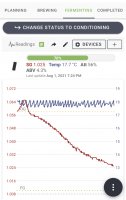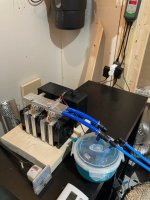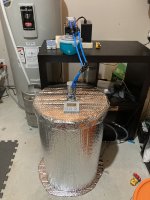You are using an out of date browser. It may not display this or other websites correctly.
You should upgrade or use an alternative browser.
You should upgrade or use an alternative browser.
Peltier
- Thread starter Syncman
- Start date

Help Support Homebrew Talk:
This site may earn a commission from merchant affiliate
links, including eBay, Amazon, and others.
- Joined
- Feb 16, 2012
- Messages
- 4,642
- Reaction score
- 7,061
- Location
- At home, in the brewery in Maryland.
You could try Brew Jacket. Their system uses an immersion rod with a peltier mounted on top. It's capable of chilling to 15~25°F below ambient temperature depending on your insulation around your fermenter, and your patience. It will maintain a temperature but takes forever to get to temperature. I used one for a couple of years. An evaporative fan cools the peltier and cycles frequently. No louder than a CPU fan on an old tower PC, but might be annoying to you in a small living area.Anyone successfully built a fermenter using a Peltier? I only do 2 gal batches in MR BEER kegs, and electrical efficiency is not an issue. Noise from a regular refrigerator is.
I have one of these. I've got plastic fermenters and drilled the right size hole into each, and also bought some silicone sheeting to make my own thicker, softer gaskets. But it works pretty well.
For a normal ale, even 5 gallons, it easily keeps it at around 68 during active fermentation in my ~ 70 - 75 degree basement. It did struggle recently with an Imperial Stout, 5 gallons, though. I was shooting for 60 degrees and it could only manage about 63. But that's a bit of an outlier for temp an how active that fermentation was.
I don't think it could do a lager and I definitely don't try using it for cold crashing. But as mentioned for ales, maintaining a temp not too far off ambient is no problem.
https://www.bulkreefsupply.com/iceprobe-thermoelectric-aquarium-chiller-nova-tec.html
For a normal ale, even 5 gallons, it easily keeps it at around 68 during active fermentation in my ~ 70 - 75 degree basement. It did struggle recently with an Imperial Stout, 5 gallons, though. I was shooting for 60 degrees and it could only manage about 63. But that's a bit of an outlier for temp an how active that fermentation was.
I don't think it could do a lager and I definitely don't try using it for cold crashing. But as mentioned for ales, maintaining a temp not too far off ambient is no problem.
https://www.bulkreefsupply.com/iceprobe-thermoelectric-aquarium-chiller-nova-tec.html
- Joined
- Feb 16, 2012
- Messages
- 4,642
- Reaction score
- 7,061
- Location
- At home, in the brewery in Maryland.
That was pretty much my experience as well. Worked reasonably well for ales, but lagers or cold crashing was mostly just a wish. Finally bit the bullet and went full stainless and glycol. Love it, but it does represent an investment $$$.I have one of these. I've got plastic fermenters and drilled the right size hole into each, and also bought some silicone sheeting to make my own thicker, softer gaskets. But it works pretty well.
For a normal ale, even 5 gallons, it easily keeps it at around 68 during active fermentation in my ~ 70 - 75 degree basement. It did struggle recently with an Imperial Stout, 5 gallons, though. I was shooting for 60 degrees and it could only manage about 63. But that's a bit of an outlier for temp an how active that fermentation was.
I don't think it could do a lager and I definitely don't try using it for cold crashing. But as mentioned for ales, maintaining a temp not too far off ambient is no problem.
https://www.bulkreefsupply.com/iceprobe-thermoelectric-aquarium-chiller-nova-tec.html
That was pretty much my experience as well. Worked reasonably well for ales, but lagers or cold crashing was mostly just a wish. Finally bit the bullet and went full stainless and glycol. Love it, but it does represent an investment $$$.
I'm not a lager guy, don't hate them just far more interested in ales. And bent my keg tubes to leave 3/4" or so inch space underneath for any settled yeast, meaning I basically cold crash in the frig after kegging. All that to say - so far it's actually worked out well for me.
But, yeah, some will need a lot more than this can do. I am sure the glycol rocks it out of the park.
I just built one with two peltier modules and a stainless coil inside the fermenter. I tested it with water first, and it did a good job keeping the temperature steady up to 4 degrees below room temp. And now I’m actually trying for the first time and is doing ok. The Peltier cools or heats the water that passes through it and a pump picks up that water from a little reserve and sends it through the coil inside the fermenter. A InkBird temperature controller changes the polarity to the system for heating or cooling.
Attachments
![Craft A Brew - Safale S-04 Dry Yeast - Fermentis - English Ale Dry Yeast - For English and American Ales and Hard Apple Ciders - Ingredients for Home Brewing - Beer Making Supplies - [1 Pack]](https://m.media-amazon.com/images/I/41fVGNh6JfL._SL500_.jpg)
$6.95 ($17.38 / Ounce)
$7.47 ($18.68 / Ounce)
Craft A Brew - Safale S-04 Dry Yeast - Fermentis - English Ale Dry Yeast - For English and American Ales and Hard Apple Ciders - Ingredients for Home Brewing - Beer Making Supplies - [1 Pack]
Hobby Homebrew

$58.16
HUIZHUGS Brewing Equipment Keg Ball Lock Faucet 30cm Reinforced Silicone Hose Secondary Fermentation Homebrew Kegging Brewing Equipment
xiangshuizhenzhanglingfengshop

$53.24
1pc Hose Barb/MFL 1.5" Tri Clamp to Ball Lock Post Liquid Gas Homebrew Kegging Fermentation Parts Brewer Hardware SUS304(Liquid Hose Barb)
yunchengshiyanhuqucuichendianzishangwuyouxiangongsi

$719.00
$799.00
EdgeStar KC2000TWIN Full Size Dual Tap Kegerator & Draft Beer Dispenser - Black
Amazon.com

$76.92 ($2,179.04 / Ounce)
Brewing accessories 1.5" Tri Clamp to Ball Lock Post Liquid Gas Homebrew Kegging Fermentation Parts Brewer Hardware SUS304 Brewing accessories(Gas Hose Barb)
chuhanhandianzishangwu

$20.94
$29.99
The Brew Your Own Big Book of Clone Recipes: Featuring 300 Homebrew Recipes from Your Favorite Breweries
Amazon.com

$49.95 ($0.08 / Fl Oz)
$52.99 ($0.08 / Fl Oz)
Brewer's Best - 1073 - Home Brew Beer Ingredient Kit (5 gallon), (Blueberry Honey Ale) Golden
Amazon.com

$44.99
$49.95
Craft A Brew - Mead Making Kit – Reusable Make Your Own Mead Kit – Yields 1 Gallon of Mead
Craft a Brew

$22.00 ($623.23 / Ounce)
AMZLMPKNTW Ball Lock Sample Faucet 30cm Reinforced Silicone Hose Secondary Fermentation Homebrew Kegging joyful
无为中南商贸有限公司

$176.97
1pc Commercial Keg Manifold 2" Tri Clamp,Ball Lock Tapping Head,Pressure Gauge/Adjustable PRV for Kegging,Fermentation Control
hanhanbaihuoxiaoshoudian

$33.99 ($17.00 / Count)
$41.99 ($21.00 / Count)
2 Pack 1 Gallon Large Fermentation Jars with 3 Airlocks and 2 SCREW Lids(100% Airtight Heavy Duty Lid w Silicone) - Wide Mouth Glass Jars w Scale Mark - Pickle Jars for Sauerkraut, Sourdough Starter
Qianfenie Direct

$7.79 ($7.79 / Count)
Craft A Brew - LalBrew Voss™ - Kveik Ale Yeast - For Craft Lagers - Ingredients for Home Brewing - Beer Making Supplies - (1 Pack)
Craft a Brew

$479.00
$559.00
EdgeStar KC1000SS Craft Brew Kegerator for 1/6 Barrel and Cornelius Kegs
Amazon.com

$53.24
1pc Hose Barb/MFL 1.5" Tri Clamp to Ball Lock Post Liquid Gas Homebrew Kegging Fermentation Parts Brewer Hardware SUS304(Gas MFL)
Guangshui Weilu You Trading Co., Ltd
First, welcome @Cesariocs to the forums at HBT! 
Now then...a 4° delta below room temperature functional limit just reinforces my opinion: As a fun science experiment, they're fine, but I have never seen a Peltier based cooling system as a practical solution for any problem...

Now then...a 4° delta below room temperature functional limit just reinforces my opinion: As a fun science experiment, they're fine, but I have never seen a Peltier based cooling system as a practical solution for any problem...
Last edited:
Well, it's 4C, so about 7F. Still not enough for my needs.
Syncman, I documented my peltier system in another thread here: compact peltier cooled carboy setup
Last edited:
A peltier element (or TE cooler) can't just make heat energy disappear, it moves it to the "hot side" of the element. If you don't remove that heat quickly, the element just won't work. I suppose that's pretty obvious, but it's fundamental and needs to be said.
To remove the heat, the best way is through convective cooling - typically a fan. Fans do make noise, so that might be a problem for you. If you rely solely on conductive (no fan), you'll want to have the largest heat sink with the lowest thermal resistance (°C/W) you can find. This is usually the one with the big fins.
I've used TE coolers to cool water (which then cooled laser diodes) in a medical device and it did its job well. This one below. Note the large fan on the heat sink.
https://tetech.com/product/lc-200/
To remove the heat, the best way is through convective cooling - typically a fan. Fans do make noise, so that might be a problem for you. If you rely solely on conductive (no fan), you'll want to have the largest heat sink with the lowest thermal resistance (°C/W) you can find. This is usually the one with the big fins.
I've used TE coolers to cool water (which then cooled laser diodes) in a medical device and it did its job well. This one below. Note the large fan on the heat sink.
https://tetech.com/product/lc-200/
shoengine
Whale Noun Member
Peltier was the "it" thing in cooling overclocked CPU for a minute. It was simpler to setup and was cheaper and safer than water cooling. It didn't last long though because it just wasn't efficient enough against the alternatives.
I think the same issue holds true here, as it won't free anyone from seasonal brewing. It does however have the benefit that it can keep a more consistent temperature than ambient or swamp (t-shirt) cooling methods.
I think the same issue holds true here, as it won't free anyone from seasonal brewing. It does however have the benefit that it can keep a more consistent temperature than ambient or swamp (t-shirt) cooling methods.
Similar threads
- Replies
- 8
- Views
- 278
- Replies
- 11
- Views
- 522














































